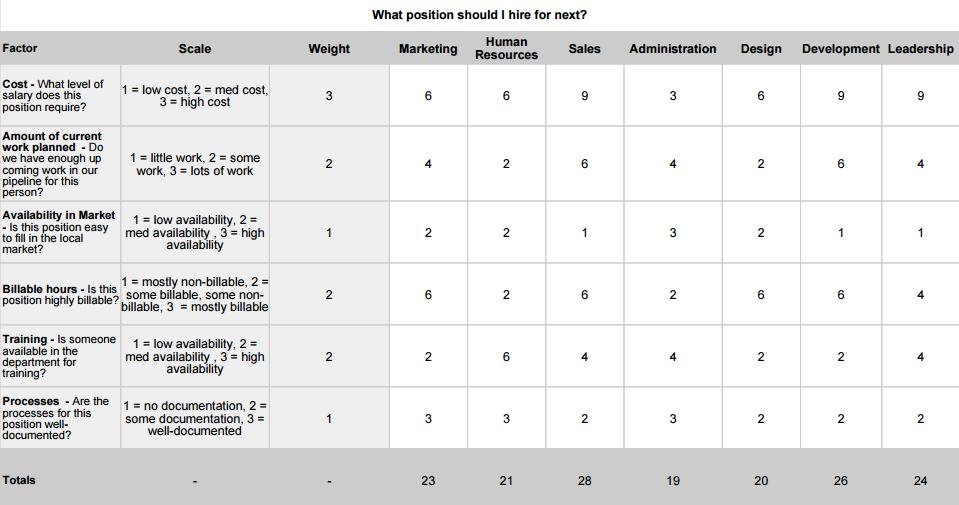Battling the Culture of Busy: Part 4 – Prioritization & Decision-Making
Learn four processes that will help you be more intentional about how you prioritize and make decisions.

If the countermeasure to being busy is being intentional, then what can we do to be more intentional in how we choose to spend our time? In this 5 part series on Battling the Culture of Busy, I will provide organization tactics in the following areas: email, meetings, task management, prioritization, and self-care.
Even the best list, is still just a list. It can be difficult to decide where to start and which items to do in what order. Add in some decision fatigue and if feels like you might as well just turn on Netflix and binge-watch Jessica Jones for all you are going to accomplish. But wait! Prioritization and decision-making, like many of the tactics and tools I have shared in my other posts, are often challenges in identifying a process to follow. If you have a few different approaches in your back pocket it can help overcome the fatigue and give the decision-making a bit of structure (says the lady who LOVES structure).
The following 4 tactics vary depending on what type of tasks you are working on but can help you be intentional about how you prioritize and make decisions.
- Start by sorting
- Value match
- 1-2-3 rating
- Decision matrix
Start by sorting

When I am looking at a long list of tasks, I find the easiest and most effective way to start is to make the list shorter so that it is not quite so overwhelming. I do this by going through each task and asking myself the following questions:
- Does this task have a hard deadline?
Sorting the tasks in order of due date/time is a great first pass since there is nothing like a deadline to get your butt in gear. - Is someone else waiting for me to finish this task?
Once you have the due dates sorted out you can see if any of the most pressing tasks also have the added pressure of having someone else waiting for you to get it done. No one wants to be a blocker so this will often move up the priority of the task. - How long will this task take me?
Next, you need to consider how long each task will take. Based on your schedule for that day, you can decide which tasks are reasonable for you to slot it in immediately and which need to be considered for another day. As I mentioned in my previous post, you can use time blocking to help with this. - How long has this task been sitting on my list?
The last thing I like to do is take a look at the items on my list and pick out the ones that have been sitting on the list the longest. These are often the tasks you don’t enjoy, or that are just not a high priority. I either try to slot them in and get them over with or decide that they should come off the list entirely.
Though these questions might seem obvious, they are a simple process to follow if you are experiencing decision fatigue or feeling really overwhelmed by the sheer number of things to do. They give you a starting point to prioritize in an intentional way and methodically work through your list until it is clearer which items should be worked on in what order.
Value match
This concept connects strongly to my post about daily reflection. The idea is to give higher priority to things that are important to you or in alignment with your values and to consider whether or not you should even do tasks that are in conflict with your values. The caveat here is that this requires that you have clarified what is important to you, and/or your values. There is also the reality that we sometimes are not in a position to make the decision to not do certain types of tasks so this approach might be less helpful in those situations.
That said, everyone has values that already exist but it can be tricky to articulate them really clearly. My company, AgileStyle, spent a lot of time (as in over a year) developing our company values, but they are something that we use regularly when making decisions. They are a guide for which projects we want to take on, how we should approach certain challenges, and how we treat our customers. We have fired customers, not taken on projects, and not hired team candidates that were in conflict with our values.
While it is not always an appropriate approach, I think it is something that isn’t used enough in decision-making or prioritization. If you have a bad feeling about a task you are supposed to do or a decision you need to make, consider where that feeling might be coming from, and whether your own values are in conflict.
1-2-3 rating

The 1-2-3 rating is something that we use when prioritizing features on a software project. We are often looking at hundreds of different possible features to include as part of development, but they usually do not all fit into the budget. In order to figure out what to build now, and what to budget for later, we work with our clients to score each feature as:
1 – Need to have
2 – Nice to have
3 – Not being considered at this time
Then we collect all the ones and price them out, usually re-evaluating if they are actually ‘need to have’s’ again, and we get a final budget. We then put the two’s into a backlog for future development and discard the three’s.
While this process is one that we use specifically for software development, it could be applied to other situations where things need to be prioritized. For example, this would be a good approach for prioritizing what to include in a home renovation. There are usually a million different things to consider, along with associated costs, so this would help work out what has to be done (e.g. electrical, plumbing, etc) and what can be added later if the budget allows (e.g. that really nice lamp).
Decision matrix
A decision matrix is a very practical approach to prioritizing and decision-making. It is most useful when you have a variety of options to choose from with many different factors to take into account. We often use this for our customers when comparing different software options but it can be used for deciding which place to go on vacation, which vacuum you should buy, which contractor you should hire to landscape your yard, etc.
The steps to create a decision matrix are as follows:
- Start with a spreadsheet.
- List all of your potential options as the column labels (x-axis).
- List all of the factors/features you need to consider as the row labels (y-axis).
- Decide a scale to use for each factor. We usually do a 1, 2 or 3. Depending on the factor/feature, the meaning of each will be a little different. E.g. If cost were a factor a 1 could be low cost, 2 med cost, and 3 high cost.
- Optional: Add a multiplier to each factor to reflect the relative importance of each one in your decision. One of the factors may deserve a greater weighting in the decision. We also often use a scale of 1 to 3 with 1 being low importance and 3 being high importance.
- Fill out each column with your number.
- If you used a weighting, multiply each of your scores by the weighting.
- Total each column.
This might seem a bit confusing so I created an example decision matrix for the question: What position should I hire for next? In this example, based on the factors you included and their relative weight, you would decide that a sales person is the position you should most likely fill next.

Creating a decision matrix is a rational approach to making a decision that has many different elements to consider and can help narrow the options in a very methodical, intentional way.
Summary
We make thousands of decisions every day, keeping in mind the many competing demands on our time and attention. It can be overwhelming, even paralyzing, when you don’t even know where to start. I hope the tools/approaches I suggested provide a strategy you can consider when sitting down to look at your to-do list or when you are trying to make a complex decision.
Share
Ashley Janssen

Productivity consultant, writer, speaker, serial entrepreneur, chaos calmer, introvert, cat-lady. Lover of books, fitness, old fashioned’s, basketball, and video games.
Follow me on
Twitter
or
LinkedIn.
Hire me for
1 on 1 productivity consulting
or
speaking.
Related articles

When You Do Things Matters

What If Being Lazy Was a Good Thing?


Comments ()